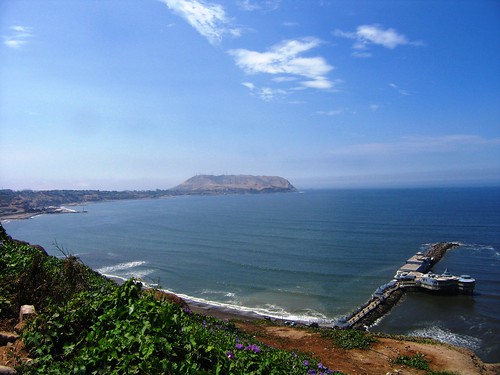Chile's borders were a matter of contention throughout the nineteenth century. The War of the Pacific began on the heels of an international economic recession that focused attention on resources in outlying zones. Under an 1866 treaty, Chile and Bolivia divided the disputed area encompassing the Atacama Desert at 24° south latitude (located just south of the port of Antofagasta) in the understanding that the nationals of both nations could freely exploit mineral deposits in the region. Both nations, however, would share equally all the revenue generated by mining activities in the region. But Bolivia soon repudiated the treaty, and its subsequent levying of taxes on a Chilean company operating in the area led to an arms race between Chile and its northern neighbors of Bolivia and Peru.
Fighting broke out when Chilean entrepreneurs and mine-owners in present-day Tarapacá Region and Antofagasta Region, then belonging to Peru and Bolivia, respectively, resisted new taxes, the formation of monopoly companies, and other impositions. In those provinces, most of the deposits of nitrate--a valuable ingredient in fertilizers and explosives--were owned and mined by Chileans and Europeans, in particular the British. Chile wanted not only to acquire the nitrate fields but also to weaken Peru and Bolivia in order to strengthen its own strategic preeminence on the Pacific Coast. Hostilities were exacerbated because of disagreements over boundary lines, which in the desert had always been vague. Chile and Bolivia accused each other of violating the 1866 treaty. Although Chile expanded northward as a result of the War of the Pacific, its rights to the conquered territory continued to be questioned by Peru, and especially by Bolivia, throughout the twentieth century.
War began when Chilean troops crossed the northern frontier in 1879. Although a mutual defense pact had allied Peru and Bolivia since 1873, Chile's more professional, less politicized military overwhelmed the two weaker countries on land and sea. The turning point of the war was the occupation of Lima on January 17, 1881, a humiliation the Peruvians never forgave. Chile sealed its victory with the 1883 Treaty of Ancón, which also ended the Chilean occupation of Lima.
As a result of the war and the Treaty of Ancón, Chile acquired two northern provinces--Tarapacá from Peru and Antofagasta from Bolivia. These territories encompassed most of the Atacama Desert and blocked off Bolivia's outlet to the Pacific Ocean. The war gave Chile control over nitrate exports, which would dominate the national economy until the 1920s, possession of copper deposits that would eclipse nitrate exports by the 1930s, greatpower status along the entire Pacific Coast of South America, and an enduring symbol of patriotic pride in the person of naval hero Arturo Prat Chacón. The War of the Pacific also bestowed on the Chilean armed forces enhanced respect, the prospect of steadily increasing force levels, and a long-term external mission guarding the borders with Peru, Bolivia, and Argentina. In 1885 a German military officer, Emil Körner, was contracted to upgrade and professionalize the armed forces along Prussian lines. In subsequent years, better education produced not only a more modern officer corps but also a military leadership capable of questioning civilian management of national development.
After battling the Peruvians and Bolivians in the north, the military turned to engaging the Araucanians in the south. The final defeat of the Mapuche in 1882 opened up the southern third of the national territory to wealthy Chileans who quickly carved out immense estates. No homestead act or legion of family farmers stood in their way, although a few middle-class and immigrant agriculturalists moved in. Some Mapuche fled over the border to Argentina. The army herded those who remained onto tribal reservations in 1884, where they would remain mired in poverty for generations. Like the far north, these southern provinces would become stalwarts of national reform movements, critical of the excessive concentration of power and wealth in and around Santiago.
Soon controlled by British and then by United States investors, the nitrate fields became a classic monocultural boom and bust. The boom lasted four decades. Export taxes on nitrates often furnished over 50 percent of all state revenues, relieving the upper class of tax burdens. The income of the Chilean treasury nearly quadrupled in the decade after the war. The government used the funds to expand education and transportation. The mining bonanza generated demand for agricultural goods from the center and south and even for locally manufactured items, spawning a new plutocracy. Even more notable was the emergence of a class-conscious, nationalistic, ideological labor movement in the northern mining camps and elsewhere.
Prosperity also attracted settlers from abroad. Although small in number compared with those arriving in Argentina, European immigrants became an important element of the new middle class; their numbers included several future manufacturing tycoons. These arrivals came from both northern and southern Europe. People also emigrated from the Middle East, Peru, and Bolivia. Although most immigrants ended up in the cities of Chile, a minority succeeded at farming, especially in the south. In the early twentieth century, a few members of the Chilean elite tried to blame the rise of leftist unions and parties on foreign agitators, but the charge rang hollow in a country where less than 5 percent of the population had been born abroad.

